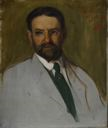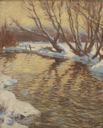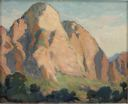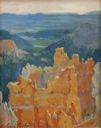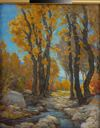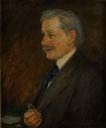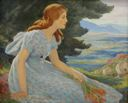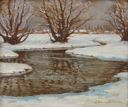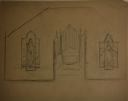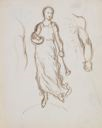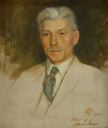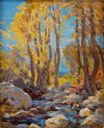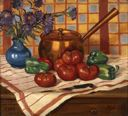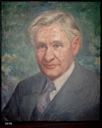Lee Greene Richards does not have an image.
Lee Greene Richards
Academie Julian, Ecole des Beaux-Arts painting, portraiture
(Salt Lake City, Utah, 1878 - 1950, Salt Lake City, Utah)
Lee Greene Richards was born in Salt Lake City, July 27, 1878. Originally named Levi, like his father, he changed his name to Lee, preferring that shortened version for "professional reasons." He grew up in Salt Lake City surrounded by artists. His grandmother, Sarah Griffith Richards, was a well-known English watercolorist. His father, Levi W. Richards, was also a painter but did not get much opportunity to paint because of the demands of pioneer life. He was, however, very interested in the art world. Lee's neighbors included George M. Ottinger, whose studio the young Richards visited often. In addition, Mahonri Young and A. B. Wright lived on the same block and the three artists became known as the "Twentieth Ward Group." They were fellow students under J. T. Harwood, along with John Sears and Louise Richards. According to Mahonri Young, Lee's academic drawings were the best of the class. Richards claimed that Harwood so effectively taught the academic methods he had learned at the Académie Julian that Richards learned as much from J. T. as from any of his later teachers in Paris. A mission for the LDS church took 18-year-old Richards to England in 1895, where he was able to visit the British museums and see original paintings by the old masters as well as to sketch and paint the lush English countryside. Richards' perceptions of the English portraitists during his museum visits impressed the young man so much that he aspired to portraiture himself. After a visit to Paris at the end of his time in England, Lee Greene Richards came home determined to earn enough money to go back to France and study art. Upon returning to Utah, he worked three years at Zions Savings Bank of Utah before realizing his dream and returning to Paris. He studied for three years (1901 - 1904), first at the Acadamie Julian (which had no entrance exam) and then, after passing the rigorous entrance exam, at the Ecole de Beaux-Arts in Paris. A successful exhibition career began with the Salon des Artists Francais in 1903. In 1904, he headed the Salon list for honorable mention, becoming the first Utah artist to receive such a distinction. Following this illustrious beginning, his successful career continued with works exhibited by the International Society of Painters, Sculptors and Etchers in London, Manchester, and Burnley, England; and at the Chicago Art Institute, the Pennsylvania Academy of Fine Arts, and the Panama-Pacific Exposition in San Francisco. After Richards' return to Utah in 1904, he received many commissions for portraits due to a combination of factors, his undoubted and internationally recognized skill, his family connections to important LDS church and community leaders, and the providential move of John Willard Clawson, an accomplished portraitist, to California. In 1908, Richards married Mary Jane Eldredge, the daughter of a well-to-do Salt Lake banker. The money Mary Jane brought to the marriage paid for a long honeymoon in Paris for the newlyweds. Then in 1910, they moved back to Utah and Lee set up a studio in the combination barn and carriage house at the back of the property, his mother-in-law's home. Lee Greene Richards painted many portraits; for those of family and close friends he used a less formal and looser style than for his official commissions. However, it was his ability to capture some integral essence of the sitter that brought him recognition in the art world. His personal philosophy of art was that art should be firmly based in the traditions of the past but, while based on "certain fundamental principles," it was up to each artist to find the particular adaptation so "he may perfectly reveal himself." Although best known for portraiture, Richards also painted still lifes, landscapes, and murals. He often painted his children and used them as models in his murals, the children posed in appropriate costumes. The early years of the Great Depression saw a revival of historical and genre painting in Utah. Murals were commissioned for the dome of the state capital building, and Richards was one of the artists heavily involved in their completion. With a number of artists working on projects depicting Utah heritage and culture, the number of paintings of pioneers increased. Lee Greene Richards was one of the most active muralist and easel painters in this regionalist phenomena.
Academie Julian, Ecole des Beaux-Arts painting, portraiture
(Salt Lake City, Utah, 1878 - 1950, Salt Lake City, Utah)
Lee Greene Richards was born in Salt Lake City, July 27, 1878. Originally named Levi, like his father, he changed his name to Lee, preferring that shortened version for "professional reasons." He grew up in Salt Lake City surrounded by artists. His grandmother, Sarah Griffith Richards, was a well-known English watercolorist. His father, Levi W. Richards, was also a painter but did not get much opportunity to paint because of the demands of pioneer life. He was, however, very interested in the art world. Lee's neighbors included George M. Ottinger, whose studio the young Richards visited often. In addition, Mahonri Young and A. B. Wright lived on the same block and the three artists became known as the "Twentieth Ward Group." They were fellow students under J. T. Harwood, along with John Sears and Louise Richards. According to Mahonri Young, Lee's academic drawings were the best of the class. Richards claimed that Harwood so effectively taught the academic methods he had learned at the Académie Julian that Richards learned as much from J. T. as from any of his later teachers in Paris. A mission for the LDS church took 18-year-old Richards to England in 1895, where he was able to visit the British museums and see original paintings by the old masters as well as to sketch and paint the lush English countryside. Richards' perceptions of the English portraitists during his museum visits impressed the young man so much that he aspired to portraiture himself. After a visit to Paris at the end of his time in England, Lee Greene Richards came home determined to earn enough money to go back to France and study art. Upon returning to Utah, he worked three years at Zions Savings Bank of Utah before realizing his dream and returning to Paris. He studied for three years (1901 - 1904), first at the Acadamie Julian (which had no entrance exam) and then, after passing the rigorous entrance exam, at the Ecole de Beaux-Arts in Paris. A successful exhibition career began with the Salon des Artists Francais in 1903. In 1904, he headed the Salon list for honorable mention, becoming the first Utah artist to receive such a distinction. Following this illustrious beginning, his successful career continued with works exhibited by the International Society of Painters, Sculptors and Etchers in London, Manchester, and Burnley, England; and at the Chicago Art Institute, the Pennsylvania Academy of Fine Arts, and the Panama-Pacific Exposition in San Francisco. After Richards' return to Utah in 1904, he received many commissions for portraits due to a combination of factors, his undoubted and internationally recognized skill, his family connections to important LDS church and community leaders, and the providential move of John Willard Clawson, an accomplished portraitist, to California. In 1908, Richards married Mary Jane Eldredge, the daughter of a well-to-do Salt Lake banker. The money Mary Jane brought to the marriage paid for a long honeymoon in Paris for the newlyweds. Then in 1910, they moved back to Utah and Lee set up a studio in the combination barn and carriage house at the back of the property, his mother-in-law's home. Lee Greene Richards painted many portraits; for those of family and close friends he used a less formal and looser style than for his official commissions. However, it was his ability to capture some integral essence of the sitter that brought him recognition in the art world. His personal philosophy of art was that art should be firmly based in the traditions of the past but, while based on "certain fundamental principles," it was up to each artist to find the particular adaptation so "he may perfectly reveal himself." Although best known for portraiture, Richards also painted still lifes, landscapes, and murals. He often painted his children and used them as models in his murals, the children posed in appropriate costumes. The early years of the Great Depression saw a revival of historical and genre painting in Utah. Murals were commissioned for the dome of the state capital building, and Richards was one of the artists heavily involved in their completion. With a number of artists working on projects depicting Utah heritage and culture, the number of paintings of pioneers increased. Lee Greene Richards was one of the most active muralist and easel painters in this regionalist phenomena.
Artist Objects

